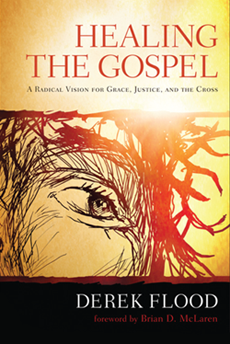How to Read the Bible Like an Anabaptist: A Jesus-shaped hermenutic
Sunday, June 17, 2012
(re-posted from RLC)
How does a “Red Letter Christian” read the Bible? From the name, you’d
think it means that we focus on the red letters of Jesus. This is
certainly true. But does that mean that we ignore the regular black
letters of, for instance, the Apostle Paul? Some would say yes. They
would argue that we need to prioritize the Gospels over Paul’s epistles
because we have put too much focus on believing the right things about
Jesus, and not enough focus on actually following Jesus. After
all, Jesus clearly says in John “If you love me, keep my commands” and
then adds “This is my command: Love each other as I have loved you.”
Believing stuff about God doesn’t matter much if you don’t live it. As
the saying goes, they will know we are Christians by our love. Our most powerful witness is when we show Jesus to people by our lives.
Nevertheless, I’d argue that this does not mean that we should stop reading Paul. Rather, we need to read both Paul’s letters and the Gospels with a focus on living the way of Jesus as part of a loving relationship with God where we grow to look and act like Jesus, rather than with a focus on abstract doctrine. Paul’s letters are in fact full of pastoral advice to churches about how to live Jesus-shaped lives. So the focus is not on reading just one part of the Bible and ignoring others, but on reading all of the Bible with a focus on following Jesus. As Tony Campolo writes in his book Red Letter Christians, “We emphasize the ‘red letters’ because we believe that you can only understand the rest of the Bible when you read it from the perspective provided by Christ.” In other words, all of the Bible needs to be read and interpreted in a way that points to its ultimate focus–which is Jesus.
Nevertheless, I’d argue that this does not mean that we should stop reading Paul. Rather, we need to read both Paul’s letters and the Gospels with a focus on living the way of Jesus as part of a loving relationship with God where we grow to look and act like Jesus, rather than with a focus on abstract doctrine. Paul’s letters are in fact full of pastoral advice to churches about how to live Jesus-shaped lives. So the focus is not on reading just one part of the Bible and ignoring others, but on reading all of the Bible with a focus on following Jesus. As Tony Campolo writes in his book Red Letter Christians, “We emphasize the ‘red letters’ because we believe that you can only understand the rest of the Bible when you read it from the perspective provided by Christ.” In other words, all of the Bible needs to be read and interpreted in a way that points to its ultimate focus–which is Jesus.
So what does that Jesus-shaped focus mean practically? How does it
change how we read the Bible? One consequence is that it means leaning
to read our Bibles in the same way that Jesus did. Folks often
quote the passage from the Sermon on the Mount where Jesus says “Do not
think that I have come to abolish the Law or the Prophets; I have not
come to abolish them but to fulfill them” and take this as a blanket
approval of every part of the Old Testament. What this rather obviously
ignores is the fact that after saying this, Jesus then immediately
proceeds to say all sorts of things that throw the traditional reading
of the Old Testament on its head–loving your enemies instead of seeking
“an eye for an eye” and so on. His point of course is not to be
unfaithful to the Bible, but to be more faithful to it. But we
simply cannot do that if we read it as a flat book. We need to learn to
read it like Jesus did, leading us to find the same loving Abba he did,
and to love like he did.
The fact is, Jesus had a reputation among the religious folks of his
day of interpreting Scripture in a way that seemed absolutely scandalous
to them. He broke the Sabbath, touched the unclean, and so on. His
clear focus in all of this was on caring for those on the margins, on
prioritizing people over rules. We need to learn to read the Bible like
that too. That means we need to ask whether a passage reflects Jesus or
not. For example, once when some people were insulting Jesus, his
disciples asked him if they should “call down fire from heaven, in the
same way that Elijah had?” Here they are citing a clear biblical
precedent set by the prophet Elijah who had demonstrated by this that he
is a “man of God,” and they are asking Jesus if they should follow that
example. This wasn’t just a theoretical question. We know that, before
his conversion, Paul took part in the stoning of Stephen. So lots of
people really thought back then that killing people was an act of
faithfulness to God. That’s how many folks read their Bibles then,
including as we can see here some of his disciples. But Jesus rebukes
them and says “You do not know what kind of spirit you are of; for the
Son of Man did not come to destroy people’s lives, but to save them.”
Here we have Jesus showing that if something does not reflect Jesus,
we need reject it like he did. That’s pretty radical, but we follow a
radical savior. Really making Jesus Lord means we need to prioritize
Jesus as the ultimate and superior revelation of God’s nature and way.
So we can look back in this way and see that the whole Bible including
the Old Testament ultimately points to Christ, but we cannot simply read
the Bible as a flat book. It is a book that is only properly
interpreted when it reflects and leads us to Jesus and his way. That’s
why Paul writes, “To this day the same veil remains when the old
covenant is read. It has not been removed, because only in Christ is it
taken away.”
Now, let me stress that all of this is my own perspective, my own
humble proposal of what a Jesus-centered reading of the Bible should
look like, and should not be taken as any kind of “official statement”
by Red Letter Christians. I say all of this as part of a community of
people who are all trying to live out a Jesus-shaped life, and believe
that the best way to do theology is in conversation and community. That
brings me to a second principle which involves the balance between
reading the Bible personally vs. reading it through the eyes of tradition.
Protestants emphasize personal interpretation, while Catholics
emphasize tradition. I’d like to propose a third way which, again, puts
Jesus at the center:
First, the key factor in a personal reading is that it must be Spirit-led.
Again, Tony Campolo stresses that “Jesus can be alive and present to
each and every person, and that salvation depends on yielding to Him and
inviting Him to be a vital, transforming presence in our lives.”
Anabaptists refer to this as the “hermeneutics of obedience” meaning
that you can only properly interpret the Bible when you are living it,
when you are really following Jesus. Note the Jesus-focus here. That
focus does not lead to us wanting to side-step difficult parts of the
Bible. In fact, the opposite is the case: The whole impetus of the RLC
movement is that many of us felt that we needed to take the words of
Jesus more seriously than we had seen it being taken by the
larger church. Some clear examples here are taking seriously Christ’s
call to love our enemies, or to care for the poor and the least. Red
Letter Christians have seen this being neglected by their tradition, and
are calling to more faithfulness to Jesus. That’s what it looks like
when a person is lead by the Spirit to faithfully speak out against the
status quo tradition.
The second point involves the positive role tradition plays in this. The key question is: what tradition?
As we all know, Christian tradition has taken some pretty horrible
turns over the years–burning people at the stake, holy wars, torture,
and so on — and remember: these were practiced by both Protestant
and Catholics alike! So what we need is not to base our reading on some
central religious authority that claims to hold the keys to the truth
(whether Catholic or Protestant). Rather, we need to read our Bibles communally as part of a body of disciples who are all actively seeking to embody and follow Jesus. Note again the Jesus-focus here: It is a Jesus-following tradition.
We need to interpret Scripture both in community with others who are
really living it, as well as hearing from those who in the past have
walked the same narrow road we are on. This is crucial because learning
how to live out the way of Jesus happens best when we can learn from the
wisdom of those who have walked that way before us — who have built on
the foundation of Christ, and demonstrate with their lives a
sophisticated vision of what following Jesus looks like. As Isaac Newton
famously said, “If I have seen further, it is by standing on the
shoulders of giants.”
Put all of that together and what we have is, in the words of Stewart Murray Williams,
(1) a Spirit-filled disciple, (2) confidently interpreting Scripture
within a community of such disciples, (3) aware that Jesus Christ is the
center from which the rest of Scripture must be interpreted.
Labels: Bible





